To blessed memory of the Dyatlov group
The incident ended only after its roots and course of events had been clarified and proven.
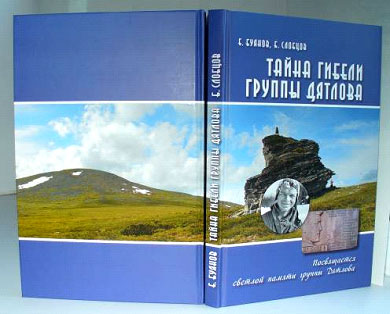
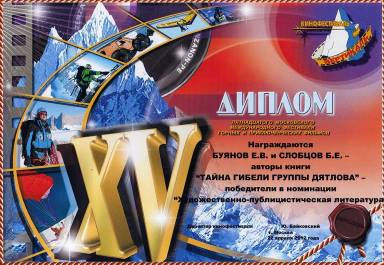

English edition dated 24 July 2013, revised and supplemented № 22, to be printed and published on the Internet
_____________ E.V. Buyanov «_____» ________ 2014
Rossia, Sankt-Peterburg,
2014
Note:
… Quite a few issues turned out to be tied with this history of death of a group of tourists, – both mysteries of missile flights, and radiation caused by nuclear tests, and mysteries of injuries, and mysteries of natural elements, and mysteries of human behavior. But in order to understand what happened on the fatal night from February 1st to February 2nd 1959, it was necessary to place all facts and events in the right place, – when where and under which circumstances they occurred. Afterwards the role of major event factors became clear – both in the incident itself, and in the multitude of rumors and legends which arose around it …
Introduction to the Internet edition 2014
The earlier version of this book published on the Internet literature sites in January 2009 was called «The mystery of Dyatlov’s accident». In August 2011 a «paper version» of the book, improved and revised, was issued in an edition of 3000 copies, with financial help of Nikolai Antonovich Rundkvist and his publishing house, Eltsin URFU (former USTU, UPI) and a fund «In memory of Dyatlov’s group» with active participation of an academician P. I. Bartolomey. We thank everyone for contribution to our book. According to a proposal of Bartolomey we changed a title of the book to «The mystery of Dyatlov’s group death» and its size was considerably cut by way of removal of some appendices (they can be found in the earlier edition). We also added several articles of other authors in order to «introduce different opinions» that existed before our book.
This book edition – more full and correct – was created on the basis of new investigation facts and as a result of constant revision of the book during last years. The huge «inertia» of the investigation of Dyatlov’s group Tragedy let us to receive new proofs and data of its events and facts but we also reached a higher level of understanding of crucial reasons of accidents increase in tourism and mountaineering during solar activity peaks, and explored connection of this factor with other natural phenomena.
This edition of the book was also issued in Internet in its English version; now foreign readers have an opportunity to become familiar with the book too.
In a complicated case investigation is not only «a search for black cats in a «dark room» where they may not be found» – this image is created by a character of the film «The meeting place cannot be changed». In this film and in the case with Dyatlov’s group, and during any serious investigation it is a movement through dark maze full of assumptions and strange facts that has a lot of «entrances» – «versions», and quite entangled paths (connections between facts and events). Only few paths lead to a reliable description of the events.
A complicated investigation process does not include only examination of one «entrance» (a version) and one «path» of the event; it requires a goal-oriented and consecutive examination of a whole «maze» of events, such as checking and explanation of all unclear facts and disproof of «false paths» of events. It demands discovering all «black cats» of Tragedy reasons and motives of people behaviour. It demands discovering a right «entrance» to the maze in the form of well-grounded version – in this case the «entrance» in the beginning was not even found. And it requires reasonable conclusion based on the examination of every strange fact as well as its connection with catastrophe events, its place and role in events development.
Only proved facts can be a base for a «tree», explaining different Tragedy events, with «fruits» – specific interpretations of some unclear facts and events. This «tree» has a main «trunk» – an explanation of a whole objective cause-and-time chain of events that took place in practice.
Those people who follow only one false version cannot find the way out of the «maze» of assumptions and leave it through «entrance» of a wrong theory (an unreliable «version» of events). Until they give up their assumptions they are doomed to wander in the «maze» aimlessly looking for evidences and facts in favour of their own wrong theory – looking for mythical facts.
Those people who follow a correct path again and again find new evidences and improvements of true «version» that turns to description of events.
In memory and on the map. Prologue
On the map of The Northern Ural, 12 km away from the dominating mountain Otorten(1182) in the riverheads of the Lozva river there is a place marked red on modern maps: «Dyatlov pass» or «Natural boundary Dyatlov pass».
The name of this remote place historically arose after the tragedy which occurred at the bottom of the mansi (voguls) «Dead mountain» Holatchakhl (Holat-Syakhyl: 1096,7 m and 1079 on old maps). Here a group of 9 tourists from the Ural polytechnical institute (UPI) under the direction of Igor Dyatlov died under mysterious circumstances at the night of February 1–2, 1959.
The reasons and course of events were unclear for a long time although lots of researchers tried to disclose them, and the place of incident and the memorable obelisk on the rock-ostanetse (single rock) turned into goals of many hikes, expeditions and searches.
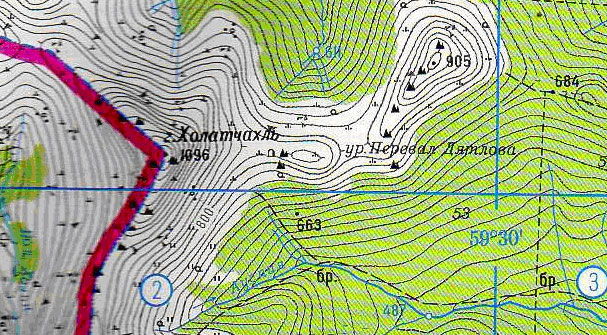
Mountain Holatchakhl (1096) and Dyatlov pass on the map of Sverdlovsk Oblast

Mountain Holatchakhl and obelisk on an ostanetse (outlier)
This history also involved facts curdling the souls of susceptible people, – mysteries on the level of thrillers. What kind of mysterious force made the group cut and tear the tent at night? Why did tourists throw their tent with stuff, went down to the forest in easy clothing where they later died from fierce frost? From what source did radioactivity spots appear on their clothing? What mysterious «fireballs» did fly at night in the Ural sky with light of «full Moon», and was this phenomenon in any way connected with the tragedy? Why and how did victims get such odd and heavy injuries, and without visible external damages? Why did one victim have no tongue?
Why did the official investigation give no answer to causes of the accident? What did the authorities hide, what did they know and what were they unaware of?? Official «case» of the prosecutor's office related to the failure, also closed for further investigation, and free access, didn't give any answer to these questions. In the conclusion regarding «irresistible force of nature» which had caused the death of tourists, there was some «innuendo», "uncertainty", "omission".
Attempts of researchers who had even studied this "criminal case" to give an answer to the mysteries of the Dyatlov incident caused new questions which didn't explain the situation, and made it more and more confused. Each «answer» to the question which rose a new question wasn't the answer, and didn't yield a correct result. Publications didn't give answers to mysteries and only gave assumptions. «Rearrangement» of facts, evidence, indications of witnesses and «versions» like «solitaire» didn't make up an integral picture of them.
Quite a few rumors, assumptions and legends arose around this story. Dozens of articles and a couple of books are dedicated to it, – Yuri Yarovoy's story «Highest category of difficulty», a documentary basis of the female novel by Anna Matveeva «Dyatlov's Pass», Anna Kiryanova's mystical thriller «Sorni-Nye\s hunting», A.Gushchin's books «A state mystery costs nine lives» (1999) and «Murder at the dead mountain» are devoted to it. Ural television agency created a TV series «The Mystery of Dyatlov Pass». This tragedy is regularly mentioned in TV programs and articles about ufologic, abnormal, paranormal and mysterious events. In the book «100 great mysteries» a story about this tragedy is narrated by the head of «Death of detachment from the Ural Polytechnical Institute».
What was this «Dyatlov incident»? Was it an ordinary "natural disaster" of a tourist group or did it involve any “technogenic” factors like falling of missiles, weapon tests? Or did the tragedy grow out of a crime, a deliberate, or undeliberate one? Or did any abnormal natural phenomena take place? And did it contain any pages «closed» by the authorities made in order to eliminate "leakage of information" about any «secrets» or actions of the authorities?
The current narration is a documentary one, – it tells about Evgeniy Buyanov's initiative investigation, assisted by a lot of other people – skilled experts and professionals. Without this help, without work of researchers’ «collective mind» the investigation wouldn’t have been able to achieve success within foreseeable terms. This book offers our explanation of the course and causes of the Dyatlov incident and analysis of false facts and versions.
The results of investigation can be understood faster, easier and in a more interesting way if the way the researchers had gone through is stated. Therefore here we have not only results, but also the process of their search, the process of overcoming numerous errors, false facts and speculations. The course of investigation was inseparable from this fight against errors. It turned out that rejecting them is even more difficult, rather than explaining the incident events because without a denial they turned into significant rejections of the main version of events. Speculation and errors became «malicious aura» of the tragedy which drove investigation into darkness of misunderstanding, and false ways of search for a «crime» in a false manner.
We gradually approached to understanding of the course of incident through vision of causes and effects of preceeding, accompanying and following events leaving out both mysteries and false imaginations. Gradually «the main lines» of investigation were determined, – those directions of search which led to detailed understanding of separate important facts. Examples are investigation lines of «injuries», «fireballs», «radiation» and others. The narration is conducted along these «lines» of investigation which give answers to the questions put. But first the narration touches upon history of disappearance of the group and its searches, earlier unprecedented in terms of scale on the huge territory of about 300 square kilometers is briefly stated. Let's begin with it before providing answers to mysteries, and to explaining, why and how the incident occurred. So:
Alarm!
The Dyatlov group" Hibina"[1] made up of nine tourists from the UPI sports club has disappeared:

– fоur students, four graduates of the UPI (Kolevatov, Krivonishchenko, Slobodin, Thibaut-Brinyol) and senior instructor of the Kourovsko-Slobodskaya tourist base Zolotaryov – the only professional sportsman and veteran, order bearer in the group.
Another member of the group, – Yuri Yudin, – fell ill on the way and returned from the settlement of the Second northern mine, from where The Dyatlov group had begun an active part of their route. Yuri Yudin reported about his return to the university sports club and went to his relatives in order to recover on holiday.
According to the route plan the Dyatlov group was supposed to send a telegram from Ivdel about the end of their campaign till February 12th, and was to get back to Sverdlovsk till February 15th. But on February 15th the telegram didn't arrive, and the group didn't return. The first people to raise an alarm were Galina Radosteva, member of the UPI tourist section, and Igor Krivonischenko, Georgiy Krivonischenko’s younger brother. Radosteva tracked the progress of all tourist groups in accordance with journal entries in the low-grade route commission of the UPI (which could coordinate only routes of the first category of difficulty, but was controlling the passing times of all UPI groups). Igor and her went to the UPI trade union committee and insisted that a telegraph request should be sent to Vizhay asking if the Dyatlob group had been there and if there had been a telegraph message confirming the end of their route. Vizhay replied that the Dyatlov group hadn’t been back to Vizhay and no telegram had been sent. Yuri Blinov, head of the group of UPI tourists who had been travelling from Sverdlovsk to Vizhay together with the Dyatlov group, also raised an alarm. Here their routes had dispersed: Blinov's group went west to to the Molebnyi Kamen ridge and mountain Isherim (1331), and The Dyatlov group went northwest towards the Poyasovyi ridge and mountain Otorten(1182, but on th emaps from those years: 1234). Rimma, Sascha Kolevatov’s sister, Dubinina, Krivonischenko and Slobodin's parents were also disturbed.
Gordo, head of sports club, and Vishnevsky, head of physical education chair at the UPI, still hesitated for a day or two expecting the group to come back, since there had been delays of groups on the route for various reasons. On February 16–17 they communicated with Vizhay again, trying to find out whether the group had come back from the campaign. But loss of group and negative answers to inquiries in Vizhay and Ivdel definitely specified that with it something happened.
They began to investigate, where The Dyatlov group had gone to. It turned out that there was no copy of the route commission (RC) protocol and route book ("marshrutka") in the sports club. Dyatlov had issued protocols in the route commission and left them there and in the city sports committee. And he took three copies of the" RC" with himself (it was discovered later). The RC protocol was found, but it had almost no information about the campaign route.
Absence of route description first complicated the work of rescuers. Action was also slowed down because Maslennikov, a person who made a final approval in the RC, who was the first one to consider and approve the plan of Dyatlov’s campaign, was not found and involved in searches at once. Other members of the RC (Korolyov, Novikova, Ufimtsev) were not aware of the route in detail. Maslennikov learned about the disappearance of the Dyatlov group only on February 20th and starting from 21.02 through Ufimtsev he actively joined the searches in order to organize the work of rescuers. After his joining the action of rescuers staff became properly organized and directed. Maslennikov, who had graduated from the UPI in 1948, a party organizer and branch manager chief of the Top-Isetsk plant (producing steel for transformers), was «in the wrong place» both in terms of his tourist experiment, and his knowledge of the route of the Dyatlov group. And also in terms of moral responsibility he felt towards the group he had approved before the campaign. And finally in terms of his organizer experience – both in tourism and in production. The plant director let Maslennikov go from work on 22.02.59 in order to help UPI rescuers.
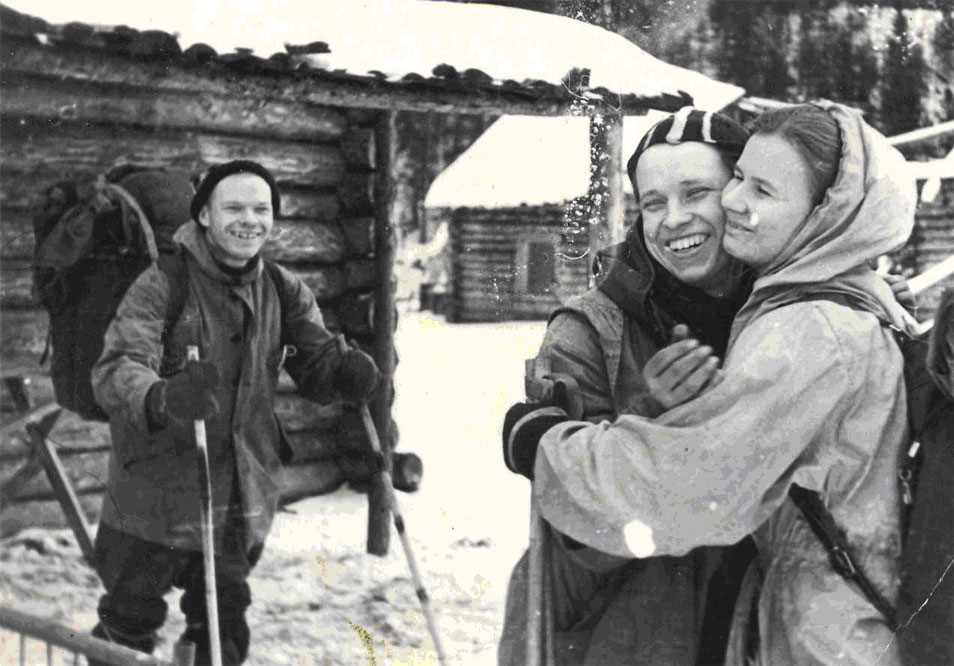
Farewell of two “economists” of the UPI: Yuri Yudin and Lyuda Dubinina in the Second Northern settlement (Dyatlov is behind). Forever …

Yudin Yuri Efimovich – (19.07.1937 – 27.05.2013, foto of 2008)
Skilled tourists could quickly organize tourists of journey groups and begin searches – they were heads of these groups. But not all of them learned about the incident at once. For example, Akselrod didn’t visit Sverdlovsk often – he lived in a worker’s settlement Sysert and worked as a senior master at the Hydro-machines plant. He learned about the loss of the Dyatlov group only on February 22nd from Dyatlov’s hostel neighbor Chiglintsev and starting from 24.02 Akselrod actively joined the searches. Only on February 24th Sergey Sogrin learned about Dyatlov’s loss. He had returned from a campaign across the Subpolar Ural Mountains where his group has got into a very difficult situation, but had managed to get out of it with only one ill member.
Lev Semenovich Gordo, head of UPI sports club, tried to agree through CS DSO “Burevestnik” about allocation of a plane for searches, but they refused him. An attempt to directly communicate with airport Ivdel thanks to support of prosecutor Tempalov was more successful. He managed to get a plane and a helicopter.
Actively recreation of the Dyatlov route was started by polling tourists and relatives, rescuers began searching for Yudin. With the help of Kolevatov’s sister Rimma rescuers found Ignatiy Fokievich Ryagin (deputy chief of Uralgipromed’) who gave the map to Sasha Kolevatov and talked to him about the forthcoming route. But the map and route books had been taken by the lost group! Ryagin restored the route and put it on another map from memory, and Rimma gave this map to rescuers on February 19th. On the same day Gordo and Blinov left for Ivdel in order to coordinate search of the Dyatlov group.
A general scheme of the route was recreated: from the Second Northern mining camp the group was going to move northeast along the valley of the Lozva river and along its head to the mountain Otorten (1182, on old maps: 1234). After a radial ascension onto this top they were planning to turn sharply towards south and along the Poyasovyi Kamen ridge to pass heads of the rivers Unya, Vishera and Niols up to mountain Oiko-Chakur (or Oikachakhl, 1322) with a radial ascension onto the top of this mountain. Straight distance between Otorten and Oiko-Chakur makes up about 70 km, but in fact the Dyatlov group was supposed to pass more than 100 km on the ridge. Later they were planning to move east from Oiko Chakur along the valleys of the Malaya Toshemka or the Bolshaya Toshemka and get to their confluence into the Severnaya Toshemka and get to the road to Vizhay along its valley, thus closing the campaign ring. Here the campaign was supposed to finish with a return to Sverdlovsk through Vizhaj-Ivdel-Serov.

Arrangement scheme of search groups
Red arrows – way of the Slobtsov group
Yellow full lines – way of the Dyatlov group
Yellow dotted line – Dyatlov's route and his spare options
White dotted ovals – search zones of groups.
(surnames of group leaders, bold arrow – landing place with conventional and serial group numbers)
White dotted arrows – concentration of groups in the Auspiya valley
Red triangle emergency tent of the Dyatlov group
Blue triangles search groups camp of rescuers on the Auspiya
Dyatlov had foreseen spare options shortening the route in case of delays, as well as emergency exits in short ways along river valleys leading to settlements in case of an emergency case in the eastern direction. Exits to the west (to the Ust-Unye, Diy, Priiskovoi) weren't provided because of their remoteness. This general scheme of route was visible, but there were a lot of possible options of its passing, especially at the final stage of the campaign. It was also not clear along which heads of the Lozva the group would go to the Otorten mountain in the initial part.
The group disappeared on this route. Tourists of the Ural Polytechnical University were captured by panic. Volunteers record began in order to form a rescue team of the UPI. On February 20th there was a meeting of tourists «state of emergency with the Dyatlov group!» for the purpose of mobilization and preparation of search groups (70 people came). Only strong guys who had tourist experience and equipment could become members of the search and rescue group, – others should not be taken. It was both unsafe and useless, – untrained people would have first needed a training on life and work in the winter taiga. Female student-tourists actively helped with organization of communication, collection and distribution of information and search of volunteers, urging familiar guys to participate in searches. On February 22nd the UPI staff of search activities was created which formed the management structure of search groups. These groups were supposed to be headed by tourists who had experience of managing several campaigns: Boris Slobtsov, Oleg Grebennik, Moisey Akselrod. From 21.02 the local prosecutor Tempalov and representatives of the UPI Blinov and Gordo were engaged in the search of tourists in Ivdel. Excerpt from Maslennikov's protocol (sheet 67 of the criminal case):
«… in the morning of 24.02 I left to Ivdel by plane. The Grebennik group, Vishnevsky and Ortyukov also flew with me. Blinov, Gordo were already in Ivdel. Blinov was the organizer of search, and Gordo was responsible for equipment …».
Note. Here and further on literal excerpts from documents and literal quotes of witnesses (without corrections) are marked in italics.
Tempalov received an instruction from Prodanov, secretary of the Ivdelsky city town committee of CPSU to take measures to search for tourists (and Prodanov himself had received this order from from regional party authorities in Sverdlovsk). Sverdlovsk ordered aviators to carry out air reconnaisance. Prodanov involved Dryakhlykh, engineer of Power wood plant who had communicated with the Dyatlov group in the 41-st quarter.
On February 21 Dryakhlykh and Blinov carried out investigation by plane along the valleys of the Auspiya and Toshemka rivers, but no traces of the Dyatlov group were found. From Blinov's diary:
«… The plan was as follows – to fly to the 2nd Northern settlement, then up along the Auspiya towards Otorten, then further to the south along the Vishera River to the mountain Oyka-Chakur, then along the valley of the Severnaya Toshemka to the settlement Northern Toshemka. Because of bad weather we didn't reach Otorten. We flew to Auspiya's middle course, flew along the Severnaya Toshemka-no traces were found.»
On February 22nd Dryachlyuh together with Gordo took off by the helicopter on northern Toshemka, where on the road of visors with itself forester Kuznetsov A.I., visited Anyamov A.P. settlement. and Bakhtiyarov P. I. yurtas. They asked Muncie on passable tourists, but traces of DyatlovDyatlovthe Dyatlov group didn't find and on finishing sites of a route of a campaign.
The organization of rescue efforts from 24.02 charged to the head of the UPI military chair to colonel George Semenovich Ortyukov. Ortyukov could agree with the chief of the Air Force of the district about allocation of the plane and two helicopters, and Maslennikov was engaged in preparation and the organization of actions of search groups of tourists and climbers. A radio communication with groups adjusted by means of Nevolin and Yaburov radio operators of the Northern geological expedition (hands. Sulman). By means of regional and local authorities and the Ministry of Internal Affairs in searches involved group of military led by captain Tchernyshov from Post/Box-6602 (connection of internal troops of the Ministry of Internal Affairs in Ivdel). Involved Moiseyev's conductors and Bridge with office and search dogs, and later – the soldier of protection of Ivdellag (Ivdel-Camp) under command of lieutenant Potapov and sappers of lieutenant colonel Shestopalov with mine detectors.
Locals also were involved in searches, – Kurikovs, Anyamov's Mancie families from the settlement Suyevatpaul and hunters of Komi. Bakhtiyarov's family conducted search of tourists in the zone of dwelling on valleys of Vizhaya and Toshemka. Some locals joined groups of search: hunters, foresters (Pashin, Kuznetsov), military (Cheglakov). Actively interrogated hunters, researchers and locals, whether saw they DyatlovDyatlov's tourist group. Warned about need to inform a search staff at detection of any traces of the gone group.
The area of search was huge, and to avia investigation and descent groups by military helicopters during searches by times very much stirred a lack of time of short winter day (only 6 hours) and adverse weather conditions. The review from the plane is very limited therefore to find group or to make out on snow traces of skis on taiga open spaces very difficult. For such region of strength of rescuers were obviously insufficient. Therefore the staff of search tried to narrow a zone of searches tactically. The main attention concentrated to the most remote, difficult and dangerous area from Otorten's mountain to Oyko-Chakur. Therefore the two first search groups decided to land near Otorten's mountain (Slobtsov's northern group) and around Oyko-Chakur (Grebennik's southern group), – in 70 km to the south of Otorten. Moving towards each other, these groups should find DyatlovDyatlov's traces and meet on ridge. To groups of searchers the task was put to find traces of the gone group: ski traces and traces of parking to leave on them to the place of incident and to assist DyatlovDyatlovThe Dyatlov group.
Search works were also saving, it was necessary as to rescue both live, and dead, – for burial and clarification of causes of death. But all hoped for the favorable outcome of searches, – here for success it was required to find for live participants of DyatlovDyatlovthe Dyatlov group as soon as possible. And the delay with search of victims was not so critical as couldn't prevent the tragedy any more.
Tactically searches built so: after disembarkation around search the group was divided into some prospecting links from 2–3 people who made within one day search of traces with light baggage in the radial directions on distance some kilometers with return to the camp. Conditions of radial investigations determined by the district, trying to guess, what way DyatlovDyatlovThe Dyatlov group could go. Then the group in full strength moved to a new point on an expected route of DyatlovDyatlovetses, equipped a new camp, and again prospected in the radial directions forces of prospecting links. Investigation in the lateral directions allowed to hope that searchers will come across sooner or later the linear ski trace left by DyatlovDyatlovthe Dyatlov group. In case of detection of such trace of group assumed to move on it, finding places of parking of DyatlovDyatlovetses and a place of their failure. Here so decided to find at first traces, and then and emergency group. Before appearance of radio operators of the instruction to groups were given by dumping of pendants from planes, and searchers gave the answer by laying on snow in the form of a conventional sign (letter).
One for other group of rescuers went to the area of search, landed from helicopters and moved on a taiga and mountains, looking for traces of the gone group. On scales and duration at that time these rescue efforts appeared unprecedented. Later longer and large-scale works took place after the «Chivruaysky tragedy» of 23.01.73 with KuAI group, – it is described below in head about failures analogs.
Boris Slobtsov's group, the youngest on structure of students, gathered the first. Two locals entered into it, – forester Ivan Pashin and the officer the Ministry of Internal Affairs (fireman) with experience of the taiga hunter Alexey Cheglakov. And also students of UPI: Vadim Brusnitsin, Stas Devyatov, Yuri Koptelov, Vyacheslav Krotov, Vladimir Lebedev, Vladimir Strelnikov, Vyacheslav Halizov, Mikhail Sharavin, – only 11 people. Group with equipment and a week stock of products from Sverdlovsk by the plane transported on military airfield of the town Ivdel on February 22. Next day by helicopters group two parts threw and landed, as late established, at the mountain Pumsalnel (1055, and on old cards: 1023) in east spur of the mountain of Otorten. In Otorten's massif there are three large tops, and in the conditions of poor visibility pilots couldn't find main of them and land group more precisely as in the beginning it was planned to deliver even closer than rescuers to Otorten, – in the upper courses of sources of river Lozva.
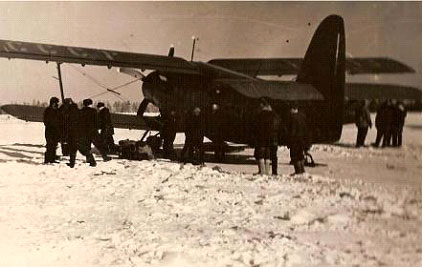
The AN-2 plane in airfield Aramil for group of rescuers (V. Brusnitsin's photo)
After disembarkation, an exit of a prospecting link to the mountain «1023» for definition of a site, descent to Lozva and the equipment of a camp Slobtsov's (23.02) group 24.02 crossed Lozva's sources, aspiring to find traces of DyatlovDyatlovthe Dyatlov group. Traces didn't find, but understood that they could remain only in a taiga. And on an open part of mountains snow represented a firm crust on which skis didn't leave traces. Therefore decided to look for traces below, in a taiga, and to cross a wood part of a valley of river Auspiya on which other possible way of DyatlovDyatlovthe Dyatlov group lay. On February 24th Slobtsov's group moved to the south, – to Auspiya's valley.
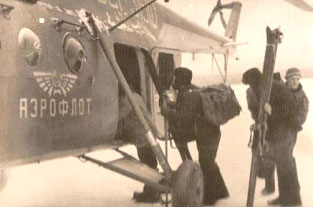
Landing in the helicopter (V. Brusnitsyn's photo)
On February 23 the settlement Suyevatpaul on Auspiya left Stepan Kurikov's group of 5 people, – Stepan, two his relatives, hunter Nikolay Anyamov and radio operator geologist Egor Nevolin.
On February 24 to the mountain area Oyko-Chakur landed Oleg Grebennik's southern group (O.I.Grebennik, Vladimir Shlyapin and 4 more tourists).
On February 26 in 30 km to the south of Otorten on a watershed in upper courses of the Vishera Rivers and Purm (approximately in 25 km from «the pass of the mountain Holatchakhl 1079») landed group of military of captain Tchernyshov with skilled pathfinders, – captain Vlasov, foreman Sidorov, the Art. the sergeant Verkhovsky and civilian Yablonsky (5 people).
Axelrod managed to agree and took off for Ivdel 24.02 together with Tipikin and Sogrin, and Axelrod's group 26.02 (around 16.00) landed in 8 km to the east of Otorten's mountain, – at the mountain Pumsalnel, where three days before and Slobtsov's group. Axelrod assumed that DyatlovDyatlovThe Dyatlov group didn't reach Otorten, and it should check this assumption for definition of the place of incident. On February 27 Axelrod with Sogrin and Tipikin surveyed Otorten's vicinities, having passed more than 40 km. From Otorten's top removed the note of Moscow State University group dated 1956. Traces of DyatlovDyatlovthe Dyatlov group didn't find.

